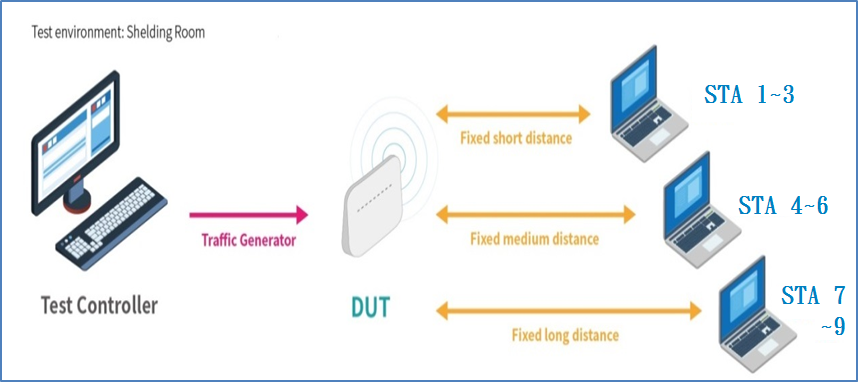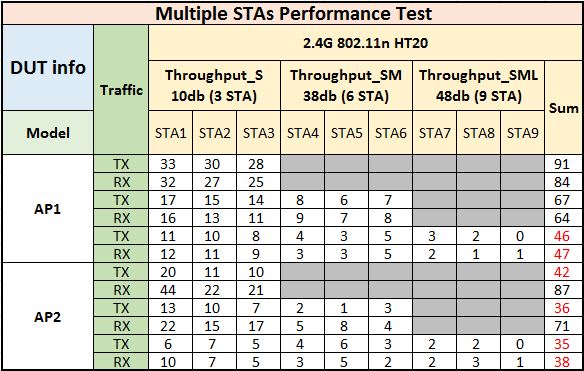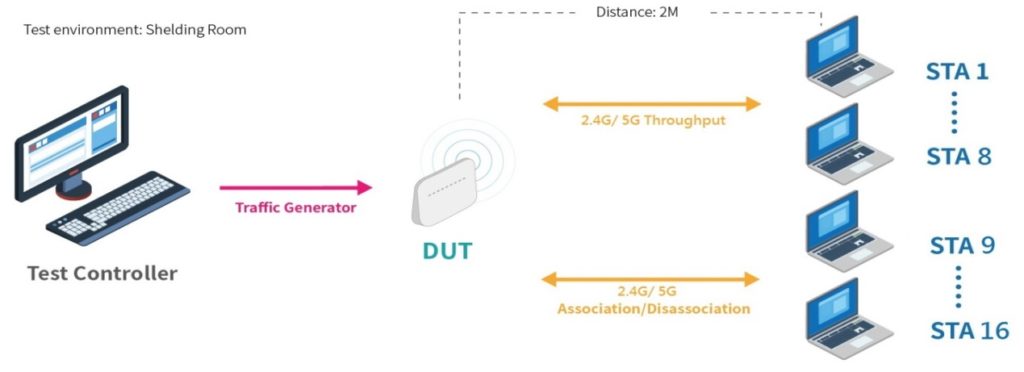Allion Labs/ Alvin Tsai & Chris Wu
From the last two articles of this series, we believe that everyone now has a deep understanding of the background and meaning of the TR-398 Standard and the test environment setup requirements. Of which, we also briefly introduced the two major test categories of the TR-398 Standard: Receiver sensitivity and bandwidth, and their test items. In this article, we will introduce five mandatory test items of category 3, coverage, and category 4, multi-user support, and their test cases.
Category 3: Coverage
3-1. Range versus Rate Test: Mandatory test
This test measures the baseband and RF chain performance of Wi-Fi devices. The attenuation of signals due to range increase is achieved by using attenuator in the stations.

This test uses signal attenuation to simulate the increase of the connection range. It can be seen from the results that at 2.4GHz 20M bandwidth, the AP can hardly reach the required standard, and the performance is not as expected; at 5GHz 80MHz, the performance is good, and can reach exceed the standard.



The measured average throughput shall satisfy the performance requirements of the following table. For each setting, the test allows up to 2 test points to be below the throughput requirements listed in the table.
| Wi-Fi Configuration (DUT) | Wi-Fi Configuration (Peer STA) | Bandwidth (MHz) | Attenuation (dB) | Throughput requirement (Mbps) | Attenuation (dB) | Throughput requirement (Mbps) | ||
| DL | UL | DL | UL | |||||
| 802.11N (Nss=2) | 802.11n (Nss=2) | 20 | 0 | 100 | 100 | 42 | 75 | 75 |
| 10 | 100 | 100 | 45 | 50 | 50 | |||
| 21 | 100 | 100 | 48 | 45 | 31 | |||
| 24 | 100 | 100 | 51 | 35 | 24 | |||
| 27 | 100 | 100 | 54 | 25 | 17 | |||
| 30 | 100 | 100 | 57 | 14 | 12 | |||
| 33 | 100 | 100 | 60 | 9 | 7 | |||
| 36 | 95 | 95 | 63 | 8 | 4 | |||
| 39 | 80 | 80 | ||||||
| 802.11ac (Nss=2) | 802.11ac (Nss=2) | 80 | 0 | 560 | 560 | 42 | 100 | 100 |
| 10 | 530 | 530 | 45 | 45 | 45 | |||
| 21 | 420 | 420 | 48 | 25 | 25 | |||
| 24 | 400 | 400 | 51 | 5 | 5 | |||
| 27 | 360 | 360 | 54 | 1 | 1 | |||
| 30 | 300 | 300 | 57 | |||||
| 33 | 220 | 220 | 60 | |||||
| 36 | 150 | 150 | 63 | |||||
| 39 | 125 | 125 | ||||||
3-2 Spatial Consistency Test: Mandatory Test
The main purpose of the spatial consistency test is to verify the Wi-Fi signal consistency in spatial domain, measuring the average performance of the connection between the device under test (DUT) and the station (STA).
The average user may place the Wi-Fi router on the edge of the house, mainly because it is close to the network connector on the wall, but this directly leads to poor signals due to increased range, especially when certain signals need to pass through walls. Generally, the signal emitted by the antenna is circular and radial. So, when there’s only one router, it can be placed in a central location to obtain the best coverage.

According to the results of the spatial consistency test, it can be seen that the signals on the left and right sides of the AP are relatively weak, and the same situation is true in either 2.4 GHz or 5 GHz; so, there may be a defect in the design of the hardware or the antenna itself.



The measured average throughput of each angle shall satisfy the requirements of the following table:
| Wi-Fi Configuration (DUT) | Wi-Fi Configuration (Peer STA) | Bandwidth (MHz) | Throughput under different attenuation (Mbps) | |||||
| Weak Signals | Medium Signals | Strong Signals | ||||||
| DL | UL | DL | UL | DL | UL | |||
| 802.11n(Nss=2) | 802.11n(Nss=2) | 20 | 90 | 90 | 70 | 70 | 35 | 35 |
| 802.11ac(Nss=2) | 802.11ac(Nss=2) | 80 | 500 | 500 | 200 | 200 | 100 | 100 |
The maximum variation during rotation shall satisfy the requirements in the following table:
| Wi-Fi Configuration | Wi-Fi Configuration (Peer STA) | Bandwidth (MHz) | Variation under attenuation (%) | |||||
| Strong signals | Medium signals | Weak Signals | ||||||
| DL | UL | DL | UL | DL | UL | |||
| 802.11n(Nss=2) | 802.11n(Nss=2) | 20 | 30% | 30% | 30% | 30% | 30% | 30% |
| 802.11ac(Nss=2) | 802.11ac(Nss=2) | 80 | 40% | 40% | 40% | 40% | 40% | 40% |
Category 4: Multiple STAs Performance (Capacity)
4.1 Multiple STAs Performance Test: Mandatory Test
This test measures the performance of Wi-Fi device connected with multiple STAs simultaneously. To simulate a circumstance of real environment, various levels of signal reflecting various distances between Wi-Fi device and STA are considered in the test.
Since most APs are used in open space, most devices are connected at different distances, which is the most common user condition in real-life scenarios. In this case, the stability and performance of the connections are relatively important.

The throughput of peer STAs shall satisfy the requirements of the following table
| Wi-Fi Configuration (DUT) | Wi-Fi Configuration (Peer STA) | Bandwidth (MHz) | Throughput_S (Mbps) | |||||
| DL | UL | DL | UL | DL | UL | |||
| 11n(Nss=2) | 11n(N=2) | 20 | 70 | 70 | 60 | 60 | 50 | 50 |
| 11ac(Nss=2) | 11ac(Nss=2) | 80 | 500 | 500 | 400 | 400 | 300 | 300 |


It can be seen from the results that the performance of AP 2 in the multiple STAs connection is significantly poor.
4-2. Multiple Association/Disassociation Stability Test: Mandatory Test
This test measures the stability of 16 Wi-Fi devices under a dynamic environment with frequent change of connection status. In a general open space, a large number of devices will be connected / disconnected with APs. At this time, the stability and performance of the AP are important.

The disassociation/association does not affect the performance of other peer STAs: (1) Error-free UDP traffic rate is at least 99% of the configured rate for each STA.
4-3. Downlink MU-MIMO Performance Test: Mandatory test
This test verifies the performance of Wi-Fi device when Downlink MU-MIMO is applied. The test is only applicable to Wi-Fi devices that support 802.11ac. Downlink
MU-MIMO capability is also known as 802.11ac Wave 2.

To pass the test case, the recorded results shall meet the pass/fail criteria, described as following:
- The sum of STA1_throughput_2, STA2_throughput_2, and STA3_throughput_2 shall be at least 45% of the sum of STA1_throughput_1, STA2_throughput_1, and STA3_throughput_1.
- The sum of STA1_throughput_2, STA2_throughput_2, and STA3_throughput_2 shall be greater than the sum of STA1_throughput_3, STA2_throughput_3, and STA3_throughput_3. These metrics shall only apply to the DUT that supports the configuration to disable DL MU-MIMO.
In this article, we introduced the categories 3 and 4, coverage and multi-user support, and through the application of the test cases, the criteria for the pass/fail of each test item are specified. It is worth noting that five test items of the two categories are mandatory test of the TR-398 Standard.
In the last article of this series, we will discuss the last two mandatory test categories of the TR-398 Standard, stability and anti-interference. Stay tuned to our Tech Blogs for more TR-398 related articles!






































